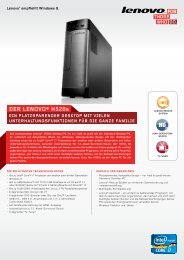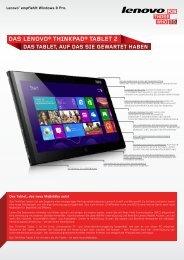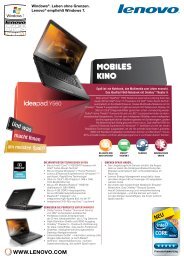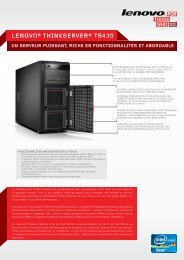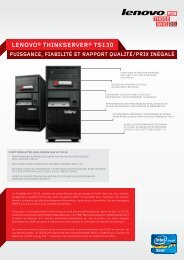You also want an ePaper? Increase the reach of your titles
YUMPU automatically turns print PDFs into web optimized ePapers that Google loves.
Solution: Make sure that:<br />
– The display device driver is installed correctly.<br />
– The screen resolution and color quality are correctly set.<br />
– The monitor type is correct.<br />
To check these settings, do as follows:<br />
For Windows 7:<br />
1. Right-click on the desktop, and click Personalize.<br />
2. Click Display at the left.<br />
3. Select Change display settings. Check whether the screen resolution is correctly set.<br />
4. Click Advanced Settings.<br />
5. Click the Adapter tab.<br />
6. Make sure that the correct device driver name is shown in the adapter information window.<br />
Note: The device driver name depends on the video chip that has been installed on your computer.<br />
7. Click the Properties button. If you are prompted for an administrator password or confirmation, type<br />
the password or provide confirmation. Check the “Device status” box and make sure the device is<br />
working properly. If not, click the Troubleshoot button. Close the Properties window.<br />
8. Click the Monitor tab. Check whether the color quality is correctly set, make sure other information<br />
is also correct.<br />
9. Click the Properties button. If you are prompted for an administrator password or confirmation, type<br />
the password or provide confirmation. Check the “Device status” box and make sure the device is<br />
working properly. If not, click the Troubleshoot button.<br />
For Windows Vista:<br />
1. Right-click on the desktop, and click Personalize.<br />
2. Click Display Settings and check whether the screen resolution and color quality are correctly set.<br />
3. Click Advanced Settings.<br />
4. Click the Adapter tab.<br />
5. Make sure that the correct device driver name is shown in the adapter information window.<br />
Note: The device driver name depends on the video chip that has been installed on your computer.<br />
6. Click the Properties button. If you are prompted for an administrator password or confirmation, type<br />
the password or provide confirmation. Check the “Device status” box and make sure the device is<br />
working properly. If not, click the Troubleshoot button.<br />
7. Click the Monitor tab.<br />
8. Make sure the information is correct.<br />
9. Click the Properties button. If you are prompted for an administrator password or confirmation, type<br />
the password or provide confirmation. Check the “Device status” box and make sure the device is<br />
working properly. If not, click the Troubleshoot button.<br />
For Windows XP:<br />
1. Right-click on the desktop, and click Properties to open the Display Properties window.<br />
2. Click the Settings tab.<br />
3. Check whether the screen resolution and color quality are correctly set.<br />
4. Click Advanced.<br />
5. Click the Adapter tab.<br />
Chapter 10. Troubleshooting computer problems 219









